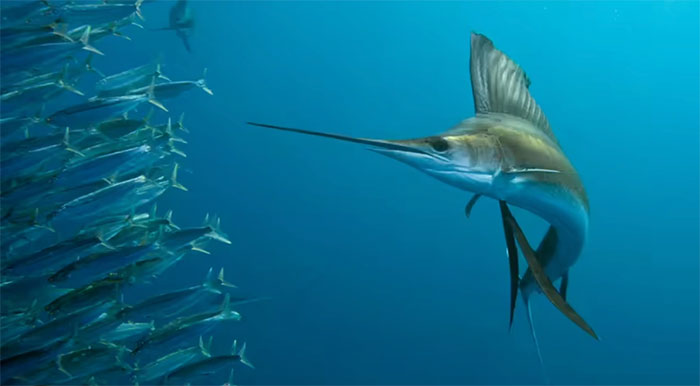The fastest swimming fish in the ocean: Competing with the 'speed king' of the steppe
What really sets this fish apart is its numerous fins arranged precisely along the body.
King of speed under the sea
There are thousands of species of fish on the seabed, but only one species of fish has retained the title of fastest swimming fish for centuries. It is a sailfish , scientific name is Istiophorus platypterus.

Sailfish can reach a maximum speed of up to 125km/h underwater. (Photo: Getty).
The name of this fish was inspired by its very large and characteristic dorsal fin, which looks quite similar to a ship's sail.
This fish lives in the warm waters of the Indian and Pacific Oceans. Thanks to its streamlined shape and powerful tail muscles, it can push water and reach a maximum speed of up to 125km/h.
This is also the same speed as the cheetah (or cheetah), which is known to be the fastest animal on land. That's why they are nicknamed the "speed king" of the steppe.
Sailfish often attack smaller fish by rushing towards them, then using their sharp, elongated beak to stab the victim.
The sails of this fish are usually folded down when they swim, and only raised when attacking prey. Raised sails have been shown to reduce sideways head oscillations.
This is likely to make it more difficult for the victim to detect an approaching predator. Accordingly, this strategy allows sailfish to get close to the school of fish, or even enter the middle of the school of fish without being noticed by their prey before attacking them.
In most cases, sailfish do not kill their prey immediately, but only severely injure them. That reduces their swimming speed, causes them to be left behind, and ultimately gives life to the hunter.
Structural differences

The structure is typical of sailfish with a system of many fins. (Photo: Wikipedia).
Being the fastest swimming fish in the water has made sailfish a subject of research for scientists for a long time.
They soon realized that what really set them apart from other fish was their system of countless fins precisely arranged along their bodies.
There, their dorsal fin is like a sail protruding from the back, and their pectoral fins are on both sides, playing an important role in navigation and speed stability.
Meanwhile, the sailfish's caudal and anal fins provide forward thrust. This is essential to achieve outstanding top speed.
Overall, this system of fins helps sailfish cross water with minimal resistance, much in the same way that many animals crouch to block the wind when they run on land.
Beneath this fish's sleek body are perfectly placed bony spines that add integrity, allowing them to reach explosive speeds without damaging internal organs.
Although it can use speed to hunt and effectively avoid enemies, sailfish are still on the list of vulnerable species.
The reason is because they depend on coral reefs as a place to feed and reproduce. Meanwhile, coral populations in many areas are showing signs of damage and decline, leading to the disappearance of this species from that area.
- This is the fastest way to swim in the world, but it is not present in competitions
- 10 species of fish set the fastest swimming record in the world
- Record in the animal world
- Speed chart of the fastest events
- The weirdest shark in the world
- Japan launches the world's fastest high-speed train
- The steppe climate
- The strange cat loves swimming and catching fish well in Vietnam
- Dizzy growth like African fish
- Hitachi will soon have the world's fastest elevator
- China launched the world's fastest railway
- Which country currently has the fastest Internet speed in the world?
 Surprised: Fish that live in the dark ocean still see colors
Surprised: Fish that live in the dark ocean still see colors Japan suddenly caught the creature that caused the earthquake in the legend
Japan suddenly caught the creature that caused the earthquake in the legend A series of gray whale carcasses washed ashore on California's coast
A series of gray whale carcasses washed ashore on California's coast Compare the size of shark species in the world
Compare the size of shark species in the world Strange species in Southeast Asia becomes the first marine fish species 'extinct due to humans'
Strange species in Southeast Asia becomes the first marine fish species 'extinct due to humans'  What time of day is the easiest to fish?
What time of day is the easiest to fish?  Special uses of a highly poisonous plant that grows throughout Vietnam
Special uses of a highly poisonous plant that grows throughout Vietnam  Why are there so many giant fish flooding the Three Gorges Dam but no one dares to catch them?
Why are there so many giant fish flooding the Three Gorges Dam but no one dares to catch them?  Specialty fish 'vong bat lieu ngu' is more expensive than gold but still sought after
Specialty fish 'vong bat lieu ngu' is more expensive than gold but still sought after  Hundreds of fish jumped out of the lake in China, what happened?
Hundreds of fish jumped out of the lake in China, what happened? 